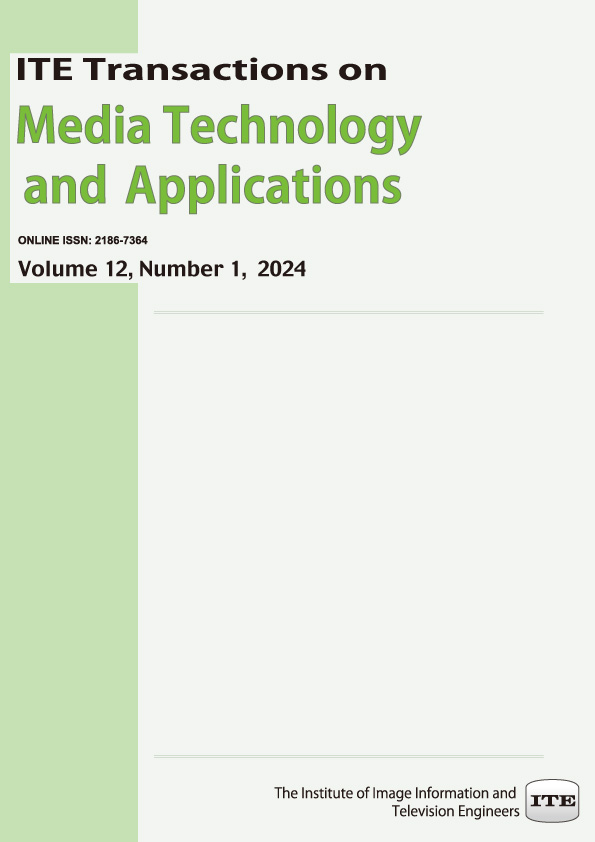Volume 12, Issue 1
Displaying 1-18 of 18 articles from this issue
- |<
- <
- 1
- >
- >|
Special Section on 3D Media Technologies in the Age of Telework
-
2024Volume 12Issue 1 Pages 1
Published: 2024
Released on J-STAGE: January 01, 2024
Download PDF (24K) -
2024Volume 12Issue 1 Pages 2-8
Published: 2024
Released on J-STAGE: January 01, 2024
Download PDF (2588K) -
2024Volume 12Issue 1 Pages 9-21
Published: 2024
Released on J-STAGE: January 01, 2024
Download PDF (7495K) -
2024Volume 12Issue 1 Pages 22-35
Published: 2024
Released on J-STAGE: January 01, 2024
Download PDF (3286K) -
2024Volume 12Issue 1 Pages 36-43
Published: 2024
Released on J-STAGE: January 01, 2024
Download PDF (3471K) -
2024Volume 12Issue 1 Pages 44-53
Published: 2024
Released on J-STAGE: January 01, 2024
Download PDF (8557K) -
2024Volume 12Issue 1 Pages 54-60
Published: 2024
Released on J-STAGE: January 01, 2024
Download PDF (859K) -
2024Volume 12Issue 1 Pages 61-67
Published: 2024
Released on J-STAGE: January 01, 2024
Download PDF (3944K) -
2024Volume 12Issue 1 Pages 68-77
Published: 2024
Released on J-STAGE: January 01, 2024
Download PDF (4874K)
Regular Section
-
2024Volume 12Issue 1 Pages 78-84
Published: 2024
Released on J-STAGE: January 01, 2024
Download PDF (3239K) -
2024Volume 12Issue 1 Pages 85-92
Published: 2024
Released on J-STAGE: January 01, 2024
Download PDF (5564K) -
2024Volume 12Issue 1 Pages 93-99
Published: 2024
Released on J-STAGE: January 01, 2024
Download PDF (2844K) -
2024Volume 12Issue 1 Pages 100-109
Published: 2024
Released on J-STAGE: January 01, 2024
Download PDF (971K) -
2024Volume 12Issue 1 Pages 110-122
Published: 2024
Released on J-STAGE: January 01, 2024
Download PDF (674K) -
2024Volume 12Issue 1 Pages 123-132
Published: 2024
Released on J-STAGE: January 01, 2024
Download PDF (920K) -
2024Volume 12Issue 1 Pages 133-142
Published: 2024
Released on J-STAGE: January 01, 2024
Download PDF (6827K) -
2024Volume 12Issue 1 Pages 143-152
Published: 2024
Released on J-STAGE: January 01, 2024
Download PDF (250K) -
2024Volume 12Issue 1 Pages 153-166
Published: 2024
Released on J-STAGE: January 01, 2024
Download PDF (11276K)
- |<
- <
- 1
- >
- >|
